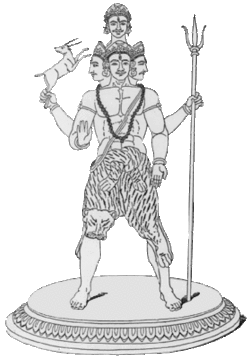Atharvashiras Upanishad
| Atharvashiras | |
|---|---|

Rudra
|
|
| Devanagari | अथर्वसिरस् |
| IAST | Atharvaśiras |
| Title means | Main point of the Atharvaveda |
| Date | 1st millennium BCE |
| Type | Shaiva |
| Linked Veda | Atharvaveda |
| Chapters | 7 |
| Philosophy | Pashupata, Vedanta |
The Atharvashiras Upanishad (Sanskrit: अथर्वसिरस् उपनिषत्) is a Sanskrit text that is one of the minor Upanishads of Hinduism. It is among the 31 Upanishads associated with the Atharvaveda. It is classified as a Shaiva Upanishad focussed on god Rudra.
The Upanishad is notable for asserting that all gods are Rudra, everyone and everything is Rudra, and Rudra is the principle found in all things, their highest goal, the innermost essence of all reality that is visible or invisible. Rudra is Atman and Brahman, and in the heart. Rudra's symbol is Om, states the text, he can be realized by abandoning anger and lust, and through silence alone. The text is known for its monism (Advaita), and was quoted extensively by the German philosopher Hegel.
It is also known as Atharvasirasopanishad, Atharvashira, Atharvasira in some texts referencing it, and as Śira Upanishad in Muktikā canon of 108 Upanishads.
The Atharvasiras Upanishad is an ancient text likely written in BCE, but its exact dating is uncertain. It is mentioned in Gautama Dharmasutras verse 19.12, Baudhayana Dharmasutra verse 3.10.10, Vasistha Dharmasutras verse 22.9 and elsewhere.
The Upanishad, states Parmeshwaranand, belongs to the category of "later Upanishads", and he dates it to approximately 5th century BCE. Deussen remarks that it is from the group of five Upanishads which assert god Shiva as a symbolism for Atman in Hinduism. These five Upanishads – Atharvashiras, Atharvashikha, Nilarudra, Kalagnirudra and Kaivalya – are ancient, with Nilarudra likely the oldest and Kaivalya the relatively later era Upanishad (still BCE) composed closer to the time of Shvetashvatara Upanishad, Mundaka Upanishad, and Mahanarayana Upanishad.
The text consists of 7 chapters, mostly prose with some verses. Several versions of the text are known, and the surviving manuscripts show evidence of being corrupted.
...
Wikipedia
